Ophidiiformes is an order of ray-finned fish that includes the cusk-eels, pearlfishes, viviparous brotulas, and others. Members of this order have small heads and long slender bodies. They have either smooth scales or no scales, a long dorsal fin and an anal fin that typically runs into the caudal fin. They mostly come from the tropics and subtropics, and live in both freshwater and marine habitats, including abyssal depths. They have adopted a range of feeding methods and lifestyles, including parasitism. The majority are egg-laying, but some are viviparous.
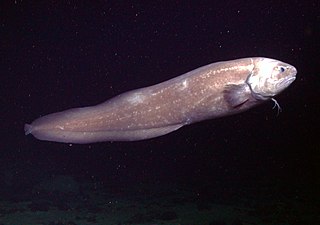
The cusk-eel family, Ophidiidae, is a group of marine bony fishes in the Ophidiiformes order. The scientific name is from the Greek ophis meaning "snake", and refers to their eel-like appearance. True eels diverged from other ray-finned fish during the Jurassic, while cusk-eels are part of the Percomorpha clade, along with tuna, perch, seahorses and others.
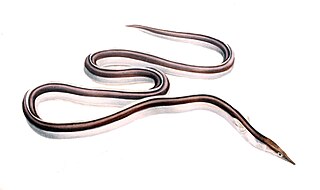
The serpent eel or sand snake-eel is an eel found in the eastern Atlantic Ocean, western Mediterranean Sea, western Indian Ocean, western Pacific Ocean and the north-east and west coast of North Island in New Zealand. It is an elongated, slender fish with a length of up to 250 centimetres. It spends the day with its body immersed in the sediment, emerging into the open water at night.

The speckled longfin eel, Australian long-finned eel or marbled eel is one of 15 species of eel in the family Anguillidae. It has a long snake-like cylindrical body with its dorsal, tail and anal fins joined to form one long fin. The dorsal fin also often extends farther than the anal fin. It usually has a brownish green or olive green back and sides with small darker spots or blotches all over its body. Its underside is paler. It has a small gill opening on each side of its wide head, with thick lips. It is Australia's largest freshwater eel, and the female usually grows much larger than the male. It is also known as the spotted eel.
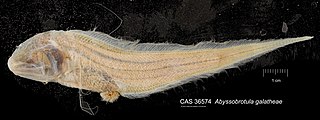
Abyssobrotula galatheae is a species of cusk eel in the family Ophidiidae. It is the deepest-living fish known; one specimen, trawled from a depth of 8,370 m (27,460 ft) in the Puerto Rico Trench in 1970, holds the record for the deepest fish ever captured. Although generally recognized, some have suggested that the record-breaking individual might have been caught with a non-closing net and therefore perhaps caught shallower.

Chilara taylori, the spotted cusk-eel, is a species of cusk-eel found along the eastern coast of the Pacific Ocean where it is found at depths down to around 280 metres (920 ft) from Washington, United States to Ecuador. This species grows to a length of 40.4 centimetres (15.9 in) TL. It is the only known member of its genus.
Eretmichthys pinnatus is a species of cusk-eel found in the ocean depths from 1,355 to 2,820 metres in the Indo-Pacific from Sulawesi and Japan to western coast of Colombia. This species grows to a length of 41 centimetres (16 in) SL. It is the only known member of its genus.

Genypterus is a genus of cusk-eels.
The filament cusk is a species of cusk-eel found in the western Pacific Ocean from the waters off of Japan to Australia and New Caledonia where it occurs at depths of from 300 to 1,000 metres. This species grows to a length of 18.4 centimetres (7.2 in) SL and is of minor importance to commercial fisheries. It is the only known member of its genus.
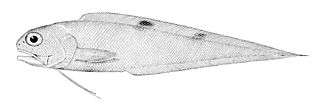
Neobythites is a genus of cusk-eels.

Sirembo is a genus of cusk-eels of the subfamily Neobythitinae, family Ophidiidae, which are found in the Indian and Pacific Oceans. The species in this genus have a rather robust body with the dorsal fin originating over vertebrae 1–5. The head and bod are completely covered in scales, they have large eyes which are almost equal in diameter to the length of snout, the pelvic fins have two rays which are joined together within an area of tough skin, They have a short spine on the operculum which does not extend to the posterior edge of the head. Their coloration is variable but almost all species have black spots or eyespots on the dorsal fin, sometimes both, while the middle part of the anal fin frequently has a black band. The body and/or head are marked with diagonal or horizontal dark stripes or horizontal rows of quite large dusky spots.

Spectrunculus is a genus of cusk-eels found in the Atlantic and Pacific Oceans.
The faceless cusk is a species of cusk-eel. It is the only species of the monotypic genus Typhlonus. It is found in the Indian and Pacific Oceans at depths from about 3,935 to 5,100 m. This species grows to 46.5 cm (18.3 in) in standard length.
The East Pacific ventbrotula is a species of cusk-eel found around thermal vents on the southern East Pacific Rise at depths of about 2,586 metres (8,484 ft). This species grows to a length of 28.2 centimetres (11.1 in) SL. It is the only known member of its genus. The generic name is a compound of vent, for the Oasis hydrothermal vent on the south East Pacific Rise and the Greek ichthys meaning "fish", while the specific name refers to the French BIOSPEEDO expedition to the south East Pacific Rise which collected the type specimen in 2004.
The striped cusk-eel is a species of fish in the family Ophidiidae. It is found in the northwest Atlantic.

The chiseltooth wrasse is a species of marine ray-finned fish, a wrasse from the family Labridae. It is native to the Indian Ocean and the western Pacific Ocean. It is an inhabitant of coral reefs and can be found at depths from 3 to 60 m, though rarely deeper than 40 m (130 ft). This species grows to 30 cm (12 in) in total length. It is of minor importance to local commercial fisheries and can be found in the aquarium trade. P. moluccanus is the only known member of its genus.
Upeneus mascareinsis, the Mascarene goatfish, is a species of marine ray-finned fish belonging to the family Mullidae, the goatfishes, which is found in the Indian Ocean.
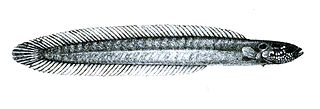
The ocellate eel blenny is a species of ray-finned fish from the subfamily Congrogadidae, which is in the family Pseudochromidae. It is the only species in the monospecific genus Blennodesmus. It is found along the northern coasts of Australia, from Western Australia, along the coast of the Northern Territory to Queensland. The ocellate eel blenny is found among coral rubble and occurs in intertidal pools up to a depth of 3 metres (9.8 ft) where it feeds mostly on crustaceans. Like other species of Congrogadid the ocellate eel blenny has eggs covered in hooks, cross shaped hooks in this species. This species has an extremely elongated body, its gill membranes are joineded to the isthmus ventrally. It has one, short lateral line which runs from its shoulder to underneath the front part of the dorsal fin. The body is dark brown in colour with mottled with paler markings and it has a black eyespot, smaller than its eye, located above the opercle. It grows to a maximum length of 8.9 centimetres (3.5 in) standard length.

Hyporthodus mystacinus, the misty grouper, black grouper, convict grouper, eightbar grouper or moustache grouper, is a species of marine ray-finned fish, a grouper from the subfamily Epinephelinae which is part of the family Serranidae, which also includes the anthias and sea basses. It is primarily found in the Caribbean and the Gulf of Mexico with populations present around the Galapagos Islands and Central American coastlines.
Spectrunculus crassus is a species of cusk-eel native to the Atlantic and eastern Pacific.













